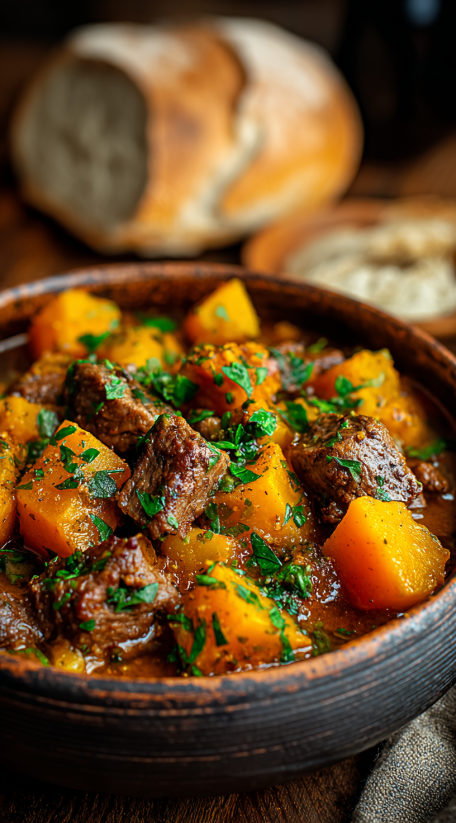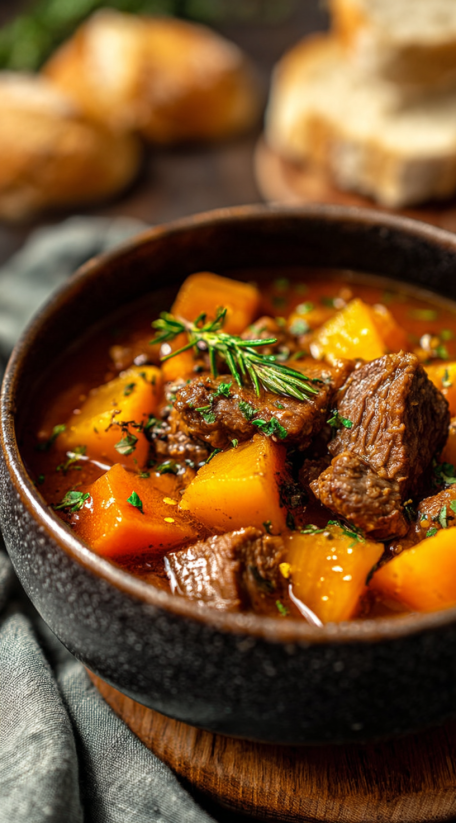 Save Pin
Save Pin
This beef stew with butternut squash is exactly what you want on a chilly night. The savory broth gets a gentle sweetness from the squash and carrots, while hunks of slow-cooked beef make it extra hearty. Every spoonful feels like pure comfort and always draws my family to the dinner table.
I remember the first time I made this stew on a Sunday when a snowstorm hit. The entire house smelled so wonderful and now whenever the temperature drops we all look forward to bringing out this recipe as our family tradition.
Ingredients
- Beef: choose chuck roast or stewing beef for the right balance of flavor and tenderness. Look for good marbling to ensure juicy results
- Butternut squash: provides natural sweetness and buttery texture. Choose squash with a firm skin and no soft spots
- Carrots: bring color and earthy sweetness. Select carrots that are brightly colored and crisp
- Celery: adds freshness and light herbal flavor. Look for firm stalks with healthy green leaves
- Potatoes: make the stew hearty and satisfying. Yukon Golds or red potatoes hold their shape well and soak up the broth
- Onions: essential for deep savory flavor. Yellow onions are my favorite for stews
- Garlic: infuses aromatic depth throughout the stew. Fresh garlic cloves make a big difference
- Beef broth: gives a rich savory base. Go for low sodium if you want more control over salt
- Thyme and bay leaves: these herbs provide warmth and aromatic background. Use fresh thyme for the best flavor but dried works too if needed
Step-by-Step Instructions
- Prep Your Ingredients:
- Take out a large cutting board and sharp knife. Cube the beef into bite-sized pieces about one inch so they cook evenly. Peel and cut the butternut squash into half inch cubes. Slice carrots into rounds chop celery into thin slices dice potatoes into large chunks and mince the garlic
- Brown the Beef:
- Warm a generous splash of olive oil in a heavy pot over medium heat. Add the beef cubes in batches so the pot is not crowded. Let each side develop a deep brown crust for several minutes without stirring too much. Remove the browned meat and set it aside in a large bowl
- Sauté the Vegetables:
- With the beef out of the pot add the diced onions carrots and celery. Stir and let these cook slowly until they start to soften and the onions become golden about five to eight minutes. The flavor from the bottom of the pot will transfer to the vegetables
- Melt the Garlic:
- Add the minced garlic to the softened vegetables and stir it for one minute so it releases aroma without burning
- Deglaze for Flavor:
- Pour a splash of beef broth into the pot using a wooden spoon to scrape up every bit of browned flavor stuck to the bottom. This makes the stew much richer
- Return Everything to the Pot:
- Add the seared beef back in along with diced potatoes butternut squash thyme sprigs and bay leaves. Pour the rest of the beef broth over everything stir to make sure all ingredients are well combined
- Simmer Until Tender:
- Bring the pot to a gentle boil then cover with a lid and turn the heat down low. Let the stew gently simmer for at least two hours stirring occasionally. The beef should be fork tender and all the vegetables fully cooked and infused with the broth
- Adjust and Finish:
- Taste your stew and season with salt and pepper as needed. Remove thyme stems and bay leaves just before serving
- Serve and Enjoy:
- Ladle the stew into deep bowls. If you like add a sprinkle of freshly chopped herbs on top. Serve piping hot
 Save Pin
Save Pin
Every time I cook this stew I love how the butternut squash slowly melts in the pot giving the broth this almost silky texture. It always reminds me of my youngest gleefully fishing out the squash pieces every time
Storage Tips
Let leftover stew cool fully before transferring to airtight containers. Store in the fridge for up to four days or freeze in single portions. For best results reheat slowly on the stovetop adding a splash of broth or water if needed to loosen the stew.
Ingredient Substitutions
If you cannot find butternut squash acorn squash or pumpkin work beautifully. No beef broth Swap for chicken broth for a lighter flavor. You can add sweet potatoes instead of regular potatoes for an earthier note. For a vegetarian version try swapping the beef for extra beans and use vegetable broth.
Serving Suggestions
This stew is so satisfying on its own but I love serving it with crusty artisan bread for soaking up the broth. Sometimes I spoon it over cooked rice or quinoa for extra heartiness. Steamed green beans or a crisp simple salad on the side round out the meal with color and freshness.
 Save Pin
Save Pin
Cultural Context
Beef stew recipes with root vegetables play an important role in many world cuisines especially across Europe and North America. The classic technique of slow simmering tougher cuts with vegetables respects both tradition and flavor. The addition of butternut squash brings a seasonal modern twist while still honoring old-fashioned comfort food.
Commonly Asked Questions
- → What cut of beef works best?
Chuck roast or stewing beef is ideal, as it becomes tender after slow simmering and brings robust flavor to the dish.
- → How can I deepen the flavor of the broth?
Browning the beef and deglazing the pot with broth helps develop savory, rich flavors. Herbs like thyme add aromatic complexity.
- → Are there suitable substitutions for butternut squash?
Kabocha or acorn squash offer similar sweetness and creamy texture, though the flavor profile may shift slightly.
- → What side dishes pair well?
Crusty bread, steamed green beans, or a fresh garden salad make excellent accompaniments for soaking up the robust broth.
- → Can I prepare this in a slow cooker?
Yes, after browning the beef and sautéing the aromatics, transfer everything to a slow cooker and cook on low for 7-8 hours.
